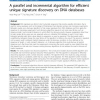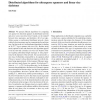10 search results - page 2 / 2 » An efficient algorithm for finding short approximate non-tan... |
BMCBI
2010
13 years 7 months ago
2010
Background: DNA signatures are distinct short nucleotide sequences that provide valuable information that is used for various purposes, such as the design of Polymerase Chain Reac...
SIGMOD
2009
ACM
14 years 7 months ago
2009
ACM
Named entity recognition aims at extracting named entities from unstructured text. A recent trend of named entity recognition is finding approximate matches in the text with respe...
CORR
2010
Springer
13 years 7 months ago
2010
Springer
Abstract. In this paper we outline initial concepts for an immune inspired algorithm to evaluate price time series data. The proposed solution evolves a short term pool of trackers...
DC
2010
13 years 7 months ago
2010
We present efficient algorithms for computing very sparse low distortion spanners in distributed networks and prove some non-trivial lower bounds on the tradeoff between time, spar...
BMCBI
2006
13 years 7 months ago
2006
Background: The problem of finding a Shortest Common Supersequence (SCS) of a set of sequences is an important problem with applications in many areas. It is a key problem in biol...


